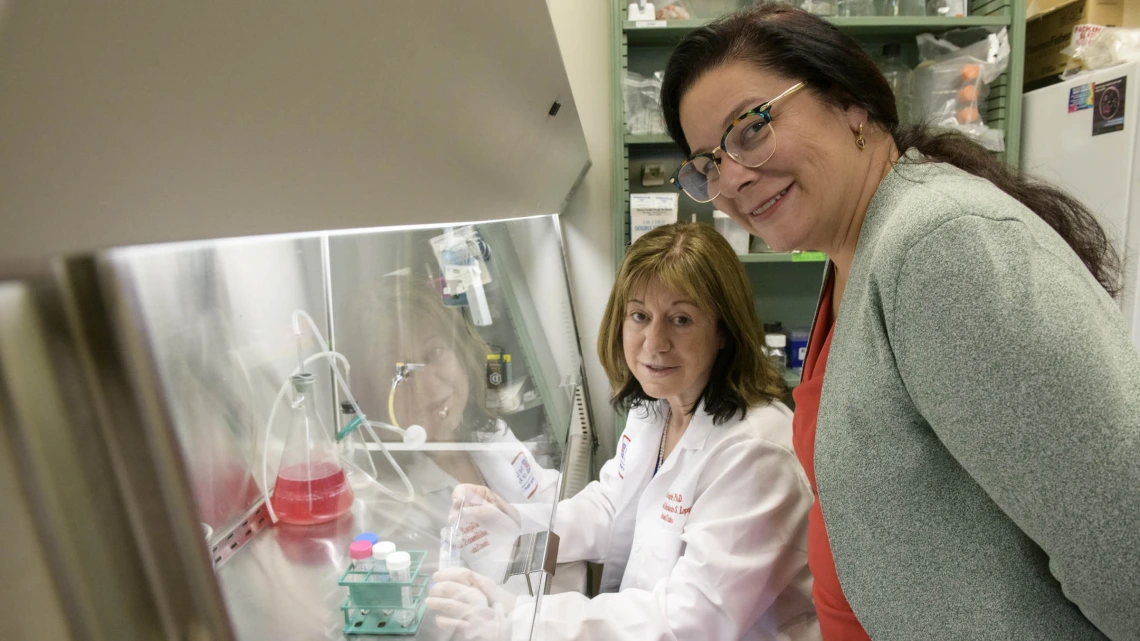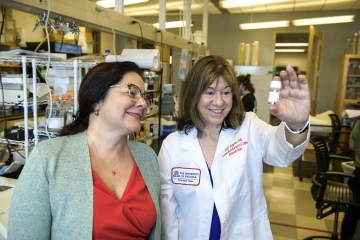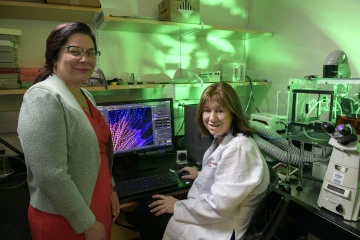Collaboration at the Heart of 35 Years of Success for Sarver Heart Center
Basic scientists and clinical researchers working together leads to center’s many achievements.

Nancy K. Sweitzer, MD, PhD, director of the Sarver Heart Center (right) and Carol Gregorio, PhD, co-director of the Sarver Heart Center, view collaboration across disciplines as key to future success for the center.
This year the Sarver Heart Center at the College of Medicine – Tucson celebrates 35 years of research, teaching, collaboration and discovery across academic disciplines. At the heart of its success is a culture of collaboration that begins at the top.
The center is led by two scientists: Nancy K. Sweitzer, MD, PhD, director of the Sarver Heart Center and division chief of cardiology at the College of Medicine – Tucson and Carol Gregorio, PhD, co-director of the Sarver Heart Center, director of the Molecular Cardiovascular Research Program and chair of the Department of Cellular and Molecular Medicine at the College of Medicine – Tucson.

Working together has proven invaluable for both Dr. Sweitzer and Dr. Gregorio as well as for students, fellows and postdocs. The two leaders have used meetings, speakers and even the pandemic to push people out of their comfort zones to collaborate.
“I like to call the Sarver Heart Center the intellectual home for people working in cardiovascular medicine, no matter what their department affiliation,” Dr. Sweitzer said.
“In university settings and academics, people have historically been in departments by training,” Dr. Sweitzer said. “But many people work on the cardiovascular system across multiple disciplines. We have Sarver Heart Center members in psychology, immunology and pharmacology, and we're all doing cardiovascular research.”
“In translational medicine, where you're moving discoveries from basic labs into therapies for patients, it requires a huge number of people to be successful. You have to build a network of people with that focus at the center.”
This partnership has proven successful in many ways.
“She's incredibly valuable to me,” said Dr. Sweitzer about Dr. Gregorio. “When we have an initiative at the Heart Center, she’s really helpful in making sure we include everyone we need so that we tap all potential resources. We do it smartly and in ways that are successful.”
“I like to call the Sarver Heart Center the intellectual home for people working in cardiovascular medicine, no matter what their department affiliation." Nancy K. Sweitzer, MD, PhD, director of the Sarver Heart Center and division chief of cardiology at the College of Medicine – Tucson
Dr. Sweitzer says the collaboration stands out in academia, complete with training that spotlights the benefits the collaborative environment can yield.
“We tag team very well,” Dr. Gregorio added, saying they invite speakers who generate excitement about collaboration. “After the presentations, we make sure there’s enough time to talk with speakers and ask questions. We provide examples of collaborations that work that include teams of scientists who get together to address important biomedical questions, frequently resulting in obtaining large grants to support the research program.”
“On Friday mornings, all labs are invited to our weekly scientific exchange sessions. We have trainees present their scientific work. We have students and postdocs and fellows present. They’re given a half an hour and there’s two who present at each meeting. This venue for scientific exchange has been organized for over 15 years.”
The camaraderie and interdisciplinary networking has produced results. The COVID-19 pandemic illustrated how pushing researchers and faculty out of their comfort zones yielded greater impact. For instance, Dr. Sweitzer said, for years she encouraged interventional cardiologists to partner with an investigator on campus examining the genetics of cells that line blood vessels and who needed clinical partners.
But because interventional cardiologists are extremely busy and focused on fixing people, it was an uphill battle. Enter COVID-19.
What was happening inside blood vessels of patients with COVID-19 was very different from anything we had seen before, Dr. Sweitzer said, meaning blood vessels were lined with blood clots, which was unusual.

Both women see preventing heart disease before it happens, eliminating health inequality and harnessing the potential of stem cells as critical to the future.
The work is advancing the science of what is occurring in blood vessels and in people having heart attacks with and without COVID-19.
“It's very exciting,” Dr. Sweitzer said.
That team approach is the look of the future. Dr. Gregorio, the inaugural holder of the Czarina M. and Humberto S. Lopez Endowed Chair for Excellence in Cardiovascular Research, said while having state-of-the-art equipment helps, more needs to be done.
“We go from a patient starting our research, and we work backwards to figure out how their disease happened,” Dr. Gregorio said. “That’s the only way for us to make a huge difference in human health care with our cutting edge science. In the future, we want to continue building productive collaborations, connecting people with different expertise and keeping our research programs state-of-the-art.”
“At the heart center level, success involves setting up core laboratory facilities with services and equipment that many scientists can use so that limited resources can be maximized without compromising quality. This makes far more sense than everyone purchasing duplicative equipment and services and helps us provide the most value to our members.”
The areas Drs. Sweitzer and Dr. Gregorio see as key to the future of the Sarver Heart Center start by preventing heart disease before it happens through preventive cardiology and community education.
“How do we better prevent more people from getting heart disease?” Dr. Sweitzer asked.
Eliminating health inequities, an area that acutely manifested itself during COVID-19, goes hand-in-hand with preventing cardiac health issues.
“We are interested in whether we can better predict risk of heart disease in vulnerable and underserved populations.” Dr. Sweitzer said. “We want to make a difference in our community by understanding unique risk profiles so that we can reduce the devastating impact of heart disease, disproportionately affecting disadvantaged persons in our community. Reducing health inequity is absolutely tied to reducing heart disease risk.”
Finally, the center is close to breakthroughs in cardiac care through the use of pluripotent stem cells.
“We’re close, but we’re not there,” Dr. Gregorio said. “Every six months to a year, there’s another huge breakthrough. Can we build a heart yet? No. But can we build a scaffold that is able to incorporate living heart cells? It’s within our lifetime. It’s really exciting. It’s just not quite there yet. At Sarver Heart Center, such research is happening now.”

